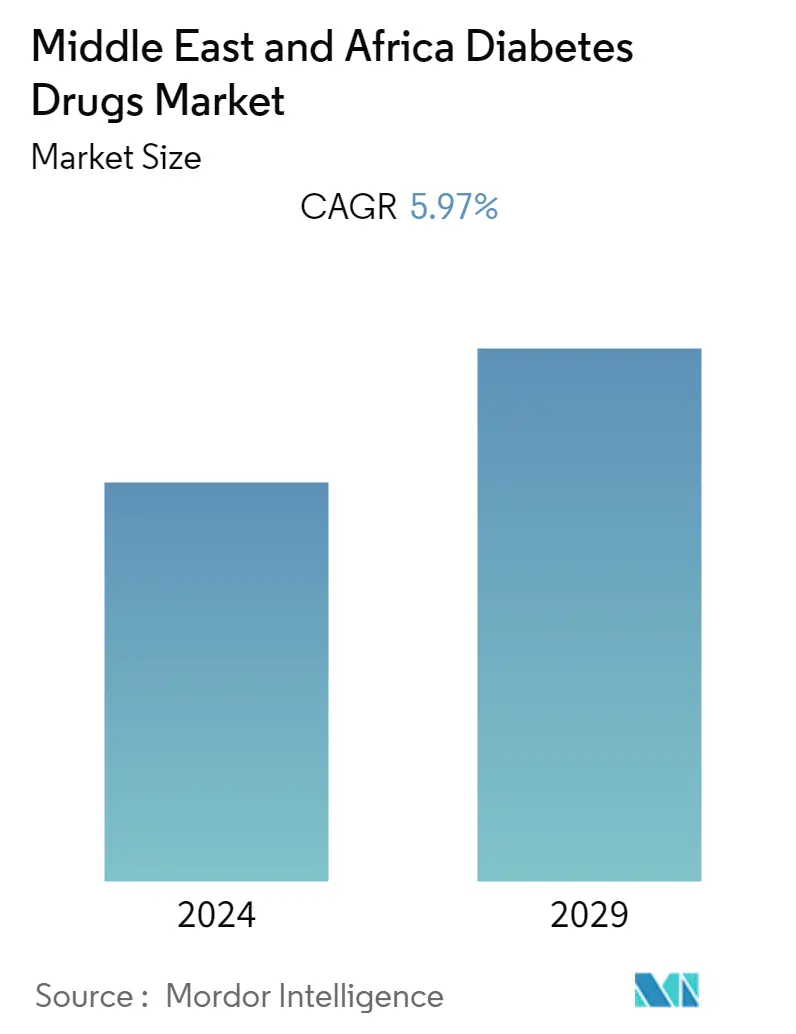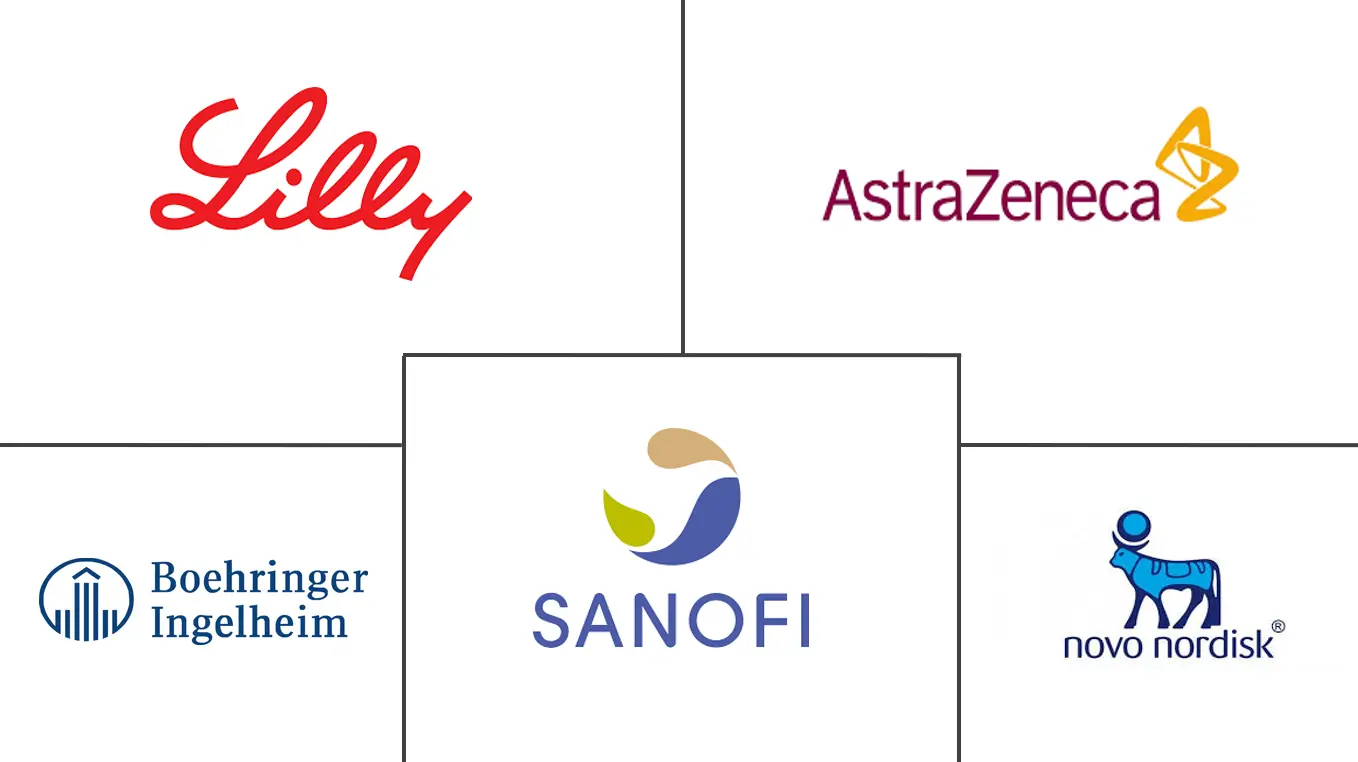Market Size of Middle East and Africa Diabetes Drugs Industry

| Study Period | 2018 - 2029 |
| Base Year For Estimation | 2023 |
| Forecast Data Period | 2024 - 2029 |
| Historical Data Period | 2018 - 2022 |
| CAGR | 5.97 % |
Major Players
*Disclaimer: Major Players sorted in no particular order |
Middle East and Africa Diabetes Treatment Market Analysis
The Middle East and Africa Diabetes Drugs Market size is estimated at USD 4.57 billion in 2023 and is expected to reach USD 6.10 billion by 2028, growing at a CAGR of 5.97% during the forecast period (2023-2028).
The COVID-19 pandemic positively impacted the Middle East and African diabetes drugs market. Diabetes and uncontrolled hyperglycemia are risk factors for poor outcomes in patients with COVID-19, including an increased risk of severe illness or death. People with diabetes have a weaker immune system, the COVID-19 complication aggravates the condition, and the immune system gets weaker very fast. People with diabetes have more chances of getting into serious complications than normal people.
Diabetic drugs are medicines developed to stabilize and control blood glucose levels among people with diabetes. Diabetic drugs are commonly used to manage diabetes. Diabetic drugs have been potential candidates for treating diabetic patients affected by SARS-CoV-2 infection during the COVID-19 pandemic. Seventy-three million adults (20-79) were living with diabetes in the IDF MENA Region in 2021. This figure is estimated to increase to 95 million by 2030. Forty-eight million adults in the IDF MENA Region live with impaired glucose tolerance, increasing their risk of developing type 2 diabetes. Diabetes was responsible for 796,000 deaths in the IDF MENA Region in 2021. USD 33 billion was spent on healthcare for people with diabetes in 2021.
The Middle East and African regions witnessed an alarming increase in the prevalence of diabetes in recent years. The rate of diabetes is at an all-time high, mainly due to lifestyle changes. Diabetes is associated with many health complications. Patients with diabetes require many daily corrections to maintain nominal blood glucose levels, such as administering additional insulin or ingesting additional carbohydrates by monitoring their blood glucose levels.
Therefore, owing to the factors mentioned above, the studied market is anticipated to witness growth over the analysis period.
Middle East and Africa Diabetes Treatment Industry Segmentation
Diabetes Drugs are used to manage diabetes mellitus by lowering the glucose level in the blood. The Middle East and Africa Diabetes Drugs Market is segmented into drugs (Insulin, Oral anti-diabetic drugs, Non-Insulin Injectable drugs, and Combination Drugs) and Geography (Saudi Arabia, Iran, Egypt, Oman, South Africa, and the rest of the Middle East and Africa). The report offers the value (in USD) and volume (in Units) for the above segments. Further, the report will cover a segment-wise breakdown (Value and Volume) for all the countries covered under the Table of Contents.
| Oral Anti-diabetic Drugs | |||||||
| |||||||
| |||||||
| |||||||
| |||||||
| |||||||
| |||||||
|
| Insulins | |||||||
| |||||||
| |||||||
| |||||||
|
| Combination drugs | |||||
| |||||
|
| Non-Insulin Injectable drugs | |||||||
| |||||||
|
| Geography | |
| Saudi Arabia | |
| Iran | |
| Egypt | |
| Oman | |
| South Africa | |
| Rest of Middle East and Africa |
Middle East and Africa Diabetes Drugs Market Size Summary
The Middle East and Africa diabetes drugs market is experiencing significant growth, driven by the rising prevalence of diabetes and the increasing demand for effective treatment options. The market is characterized by a shift towards oral anti-diabetic drugs, which are preferred due to their ease of use, cost-effectiveness, and ability to manage blood glucose levels effectively. The COVID-19 pandemic has further highlighted the importance of diabetes management, as individuals with diabetes are at a higher risk of severe complications from the virus. This has led to an increased focus on developing and distributing diabetic drugs that can help stabilize blood sugar levels and improve patient outcomes. The market is moderately fragmented, with major players like Eli Lilly, Sanofi, Novo Nordisk, and AstraZeneca actively participating and introducing innovative solutions to cater to the growing demand.
Saudi Arabia holds a significant share of the market, with a high prevalence of diabetes and a strong focus on healthcare initiatives to address the issue. The government and private sector are collaborating to enhance healthcare services, ensuring affordability, access, and quality care for diabetic patients. The introduction of new drug classes, such as DPP-4 and SGLT-2 inhibitors, has expanded treatment options, while ongoing innovations in drug formulation and technology continue to drive market growth. The presence of major manufacturers and strategic partnerships in the region is expected to maintain a competitive landscape, encouraging further advancements and expansion in the diabetes drugs market over the forecast period.
Middle East and Africa Diabetes Drugs Market Size - Table of Contents
-
1. MARKET DYNAMICS
-
1.1 Market Overview
-
1.2 Market Drivers
-
1.3 Market Restraints
-
1.4 Porter's Five Forces Analysis
-
1.4.1 Bargaining Power of Suppliers
-
1.4.2 Bargaining Power of Consumers
-
1.4.3 Threat of New Entrants
-
1.4.4 Threat of Substitute Products and Services
-
1.4.5 Intensity of Competitive Rivalry
-
-
-
2. MARKET SEGMENTATION
-
2.1 Oral Anti-diabetic Drugs
-
2.1.1 Biguanides
-
2.1.1.1 Metformin
-
-
2.1.2 Alpha - Glucosidase Inhibitors
-
2.1.2.1 Alpha - Glucosidase Inhibitors
-
-
2.1.3 Dopamine -D2 Receptor Agonist
-
2.1.3.1 Bromocriptin (Cycloset)
-
-
2.1.4 Sodium-glucose Cotransport -2 (SGLT-2) Inhibitor
-
2.1.4.1 Invokana (Canagliflozin)
-
2.1.4.2 Jardiance (Empagliflozin)
-
2.1.4.3 Farxiga/Forxiga (Dapagliflozin)
-
2.1.4.4 Suglat (Ipragliflozin)
-
-
2.1.5 Dipeptidyl Peptidase - 4 (DPP-4) Inhibitors
-
2.1.5.1 Januvia (Sitagliptin)
-
2.1.5.2 Onglyza (Saxagliptin)
-
2.1.5.3 Tradjenta (Linagliptin)
-
2.1.5.4 Vipidia/Nesina (Alogliptin)
-
2.1.5.5 Galvus (Vildagliptin)
-
-
2.1.6 Sulfonylureas
-
2.1.6.1 Sulfonylureas
-
-
2.1.7 Meglitinides
-
2.1.7.1 Meglitinides
-
-
-
2.2 Insulins
-
2.2.1 Basal or Long Acting Insulins
-
2.2.1.1 Lantus (Insulin Glargine)
-
2.2.1.2 Levemir (Insulin Detemir)
-
2.2.1.3 Toujeo (Insulin Glargine)
-
2.2.1.4 Tresiba (Insulin Degludec)
-
2.2.1.5 Basaglar (Insulin Glargine)
-
-
2.2.2 Bolus or Fast Acting Insulins
-
2.2.2.1 NovoRapid/Novolog (Insulin Aspart)
-
2.2.2.2 Humalog (Insulin Lispro)
-
2.2.2.3 Apidra (Insulin Glulisine)
-
-
2.2.3 Traditional Human Insulins
-
2.2.3.1 Novolin/Actrapid/Insulatard
-
2.2.3.2 Humulin
-
2.2.3.3 Insuman
-
-
2.2.4 Biosimilar Insulins
-
2.2.4.1 Insulin Glargine Biosimilars
-
2.2.4.2 Human Insulin Biosimilars
-
-
-
2.3 Combination drugs
-
2.3.1 Insulin combinations
-
2.3.1.1 NovoMix (Biphasic Insulin Aspart)
-
2.3.1.2 Ryzodeg (Insulin Degludec and Insulin Aspart)
-
2.3.1.3 Xultophy (Insulin Degludec and Liraglutide)
-
-
2.3.2 Oral Combinations
-
2.3.2.1 Janumet (Sitagliptin and Metformin)
-
-
-
2.4 Non-Insulin Injectable drugs
-
2.4.1 GLP-1 receptor agonists
-
2.4.1.1 Victoza (Liraglutide)
-
2.4.1.2 Byetta (Exenatide)
-
2.4.1.3 Bydureon (Exenatide)
-
2.4.1.4 Trulicity (Dulaglutide)
-
2.4.1.5 Lyxumia (Lixisenatide)
-
-
2.4.2 Amylin Analogue
-
2.4.2.1 Symlin (Pramlintide)
-
-
-
2.5 Geography
-
2.5.1 Saudi Arabia
-
2.5.2 Iran
-
2.5.3 Egypt
-
2.5.4 Oman
-
2.5.5 South Africa
-
2.5.6 Rest of Middle East and Africa
-
-
Middle East and Africa Diabetes Drugs Market Size FAQs
What is the current MEA Diabetes Drugs Market size?
The MEA Diabetes Drugs Market is projected to register a CAGR of 5.97% during the forecast period (2024-2029)
Who are the key players in MEA Diabetes Drugs Market?
Boehringer Ingelheim, Astrazeneca, Eli Lilly, Sanofi and Novo Nordisk are the major companies operating in the MEA Diabetes Drugs Market.

